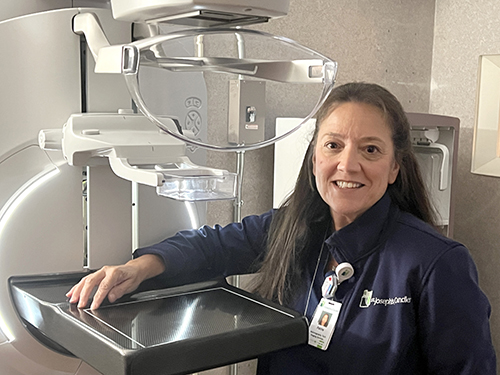What to expect during a mammogram?
Women's Care
Life-saving technology: St. Joseph’s/Candler has four locations to schedule your screening mammogram today
Almost all of us know someone who’s had breast cancer. In fact, about 1 in 8 women in the United States will develop invasive breast cancer during their lifetime. Just this year alone, the American Cancer Society estimates more than 310,700 new cases of invasive breast cancer will be diagnosed in women.
On a positive note, death rates from breast cancer have been dropping since 1989, according to the ACS. Researchers believe that’s due to early detection through screening and increased awareness.
“Mammography is still the gold standard for detecting breast cancer,” says Pattie Barnes, staff mammographer at St. Joseph’s Hospital. “Even if you don’t have a family history, even if you don’t have dense breasts, come for your screening mammogram when age appropriate because it is so vitally important.”

How mammograms work
A mammogram is radiographic imaging of the breast at different views to detect and evaluate breast changes. St Joseph’s/Candler imaging services offers 3D digital mammograms for screening and diagnostic purposes.
A mammography machine is designed to look at breast tissue. The machine has two plates that compress or flatten the breast to spread the breast tissue allowing for a better image of the breast but with less radiation used.
During a screening mammogram, the machine provides two views of each breast, Barnes says. The CC View, or cranial caudal, comes down from the top (cranial) all the way down to the caudal (meaning feet). The second view is called MLO, or mediolateral-oblique, and comes from the side at an angle.
All mammograms at St. Joseph’s/Candler are digital, therefore, images can be manipulated to enhance quality. Digital mammography is especially effective in women with dense breasts, which can be inherited and is common in younger women who haven’t gone through menopause.
“We can see millimeter abnormalities that we could not see before,” Barnes says. “We’re finding breast cancers at stage 0 to 1. It doesn’t have to get to stage 3 or 4 now before we diagnosis you.”
In addition to screenings, St. Joseph’s/Candler offers diagnostic mammography, breast ultrasounds, breast MRIs and breast biopsies.
Don’t let myths about mammography prevent you from getting screen
Barnes has been a mammographer with St. Joseph’s/Candler for more than 30 years so she’s heard all the excuses to not get screened for breast cancer.
One example is, ‘I don’t have a family history so I don’t need to worry about it.’
“I tell my patients all the time that somebody didn’t always have a family history. There was someone that started it and it might be you so you need to come for your screening mammogram,” Barnes says.
Another big myth is that mammography is painful.
“We tell them it is going to be uncomfortable but it shouldn’t be painful,” Barnes says. “It will be uncomfortable because the better the compression, the more we can see, especially with dense breasts.”
Also keep in mind that mammograms don’t typically take long so the discomfort is brief.
When and where to get a mammogram?
Yearly breast cancer screenings are recommended starting at age 40 if you are average risk. If you had a first-degree relative who had breast cancer at a young age, for example 45, you should start screening 10 years prior, so in this example age 35.
St. Joseph’s/Candler offers screening mammography at four locations: Telfair Pavilion at Candler Hospital, SJ/C Imaging Center – Pooler, SJ/C Imaging Center – Bluffton and Telfair Breast Imaging Center at Eisenhower.
Call now and schedule your next mammogram at 912-819-PINK.
Also in this series:
Coming in November: What to expect during an ultrasound